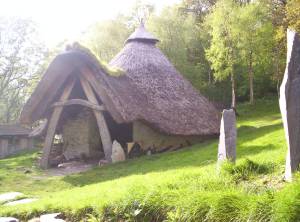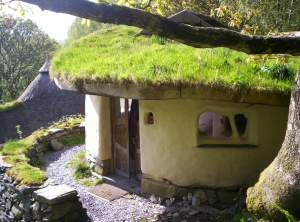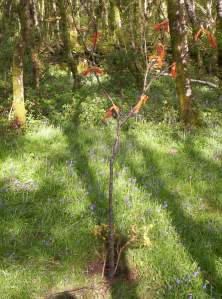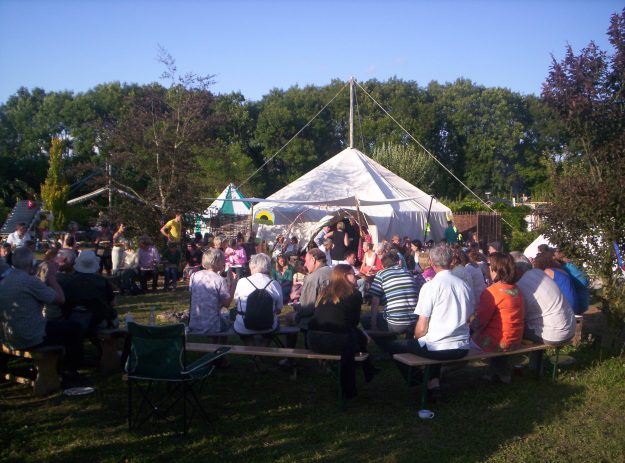1st-4th May
Talk in the Mountains
You ask me, ‘Why dwell among green mountains?’
I laugh in silence; my soul is quiet,
Peach blossom follows the moving water;
Here is a heaven and earth, beyond the world of men.
Li Po, 8th Century

In Padarn Country Park, Snowdon in the background
The Ecobardic Minifest was a small gathering exploring how we can use the Bardic Arts (poetry, storytelling, song-writing and music) to raise awareness about environmental issues), inspired by An Ecobardic Manifesto (co-written with Fire Springs) at Eric Maddern’s amazing place in North Wales, Cae Mabon – an eco-retreat centre founded in 1989. Eric, an Australian born storyteller who has put down roots in Snowdonia, was inspired by the manifesto and felt it warranted its own special event.
I travelled up with fellow Fire Springers, Anthony and Kirsty. Anthony gave me a lift from Bath – after a false start, waiting in the rain for half an hour at the wrong bus stop (it was May Eve and the Good Folk were already making their presence felt!). It was nice to have time to chat with Anthony, and then his partner Kirsty, on the long ride up. Our job was to keep Anthony awake with our conversation – a challenge for 6 hours, even for bards! We made pit-stops at the Cravens Arms and Oswestry before heading ‘into the wild’. The roads became increasingly dramatic as we headed into the heart of Snowdonia. The half-full moon seemed to be leading us all the way there (perhaps not surprising, since we were heading west but it was a reassuring ‘moon illusion’) Around midnight we paused at Pen-y-Pass, at the highest point of the Llanberis Pass, and got out to enjoy the magical moonscape. The golden section of moon sat on the dark craggy outline of the mountain, beneath a field of stars. It was a cold, clear night. Anthony drew my attention to the sound of the water running down the mountainsides, gathering in streams – skeins of silver on satin – near and far, their soft song countless murmuring echoes in the darkness. We savoured the acoustic spectacle, letting the place work its ancient wordless magic upon us. It felt right to pause at this threshold place – both physical and temporal, as we crossed ‘over’, for it was the witching hour of Beltane Eve, when the veil is thinnest. What could be a more dramatic portal than Llanberis Pass at such a time? This pause before the plunge was important – it helped us to adjust to the different reality we were about to enter. Three days of sacred time in a sacred place. The gentle magic of the water had helped us to smooth some of the brittleness of the journey. We were ready to proceed – completing the final stage in a kind of dream. Certainly the access to Eric’s place was like something from a Winsor McCay cartoon – Little Nemo in Slumberland, or perhaps more appropriately, Dreams of a (Welsh) Rarebit Fiend – as the car negotiated increasingly more absurd hairpin bends and slopes. Somehow, we made it to the small carpark – surreal in the middle of a wood on a mountain side – and lugged our packs down the fairy path into Cae Mabon’s magical kingdom, strange in the darkness, with only Anthony and Kirsty’s headlamps lighting the way. ‘Behold the shining brow!’ Anthony alarmed slumbering hobbits trying to locate our chalet. Eventually we found our cabin – Eric had kindly left on the lights – and we gratefully dumped our stuff. I cracked open a bottle of Wild Hare to celebrate our arrival/Beltane Eve and to help me get to sleep. It was nearly 3 am. I sat in A&K’s room briefly while we ‘decelerated’. After an exhausting journey – when we were all in danger of nodding off – now we suddenly felt (relatively) wide awake. As soon as we had arrived and had stepped out of the car, it felt like all the effort of the journey had been worth it – the fatigue had melted away. I felt like I could of stayed up until dawn – and see in the May – but I wanted to be able to function the next day, so I made myself go to sleep. But no sooner had my head hit the pillow, I was off into the Land of Nod.

Cae Mabon roundhouse
Despite being so late to bed I was the first one up for breakfast – my stomach is the best alarm clock! I made my way down the path to the hall – enchanted by the beauty of the place in the daylight, beholding it for the first time. Cae Mabon consists of a small ‘village’ of eco-buildings: a cob-house, hogan, roundhouse, longhouse, hobbit hut, etc. Many had turf-roofs with blue bells growing on them. The shapes were rounded, organic, as though they had grown out of the land, responding to the aesthetics of place – the curves and kinks in the landscape with slate, wood, thatch. I can see why Cae Mabon has been named the best eco-building project in Britain. Seeing a place like this gives me hope for the future.

Cob-house, Cae Mabon
I met Martin – our incredible chef for the weekend – and Keith, a chippy who lives on sight. I got to have first pickings at his wholesome breakfast – fruit porridge, freshly baked bread, fresh eggs, gallons of tea – as the other participants started to appear.
We gathered officially at ten for our first meeting and discussed what we wished to do over the next three days. The weekend programme evolved in a very organic democratic way. Eric had a gentle hand on the tiller.
We agreed to create a ceremony to celebrate Beltane (May Day) later that day, but the morning was given over to a general discussion about Ecobardism – triggered by Anthony’s excellent ‘keynote’ speech. After the first of increasingly superlative meals, we had a session on ‘Mapping the Fields’ – the territory of Ecobardism. Basically what it means, what it involves, what it tries to tackle.
After this brainwork, we set to work devising our ceremony…
Eric, in his ‘creation myth’ of Cae Mabon, wisely writes:
‘One thing that is common to many groups is the creative use of ritual and ceremony. It seems that for many the old religious rituals do not serve any more. But they cannot dispense with ceremony entirely.
‘The impulse to ritual – the symbolic use of words and actions to intensify experience, to create meaning and to dignify the individual – is deep. In a place like this it is possible to devise rituals that pay homage to ancestors, that honour Nature, that appreciate beauty, that draw on traditions, that reflect the life stories and dreams of the people involved.’
We discussed what elements we wished to include: a honouring of the Green Man and the Goddess; contributions of poetry and song; the four elements; use of the immediate environment as a ritual landscape; Welsh May customs, including a lighting of a sacred fire from nine native woods, the procession of the Cangen Haf, the Summer Pole, and a Welsh Calan Mai carol. These later, indigenous elements, were given authenticity by the presence of two Welsh speakers – Gwynn, a man from the north and Angharad, a woman from the south. Because of arrivals and departures around 5pm we had a finite amount of time and a tight turnaround. We were given half an hour to prepare – select a branch from our chosen tree, gather rags for the Summer Branch, create a posy for the Spring Goddess, prepare the fire, etc – but the time limit galvanised us into action and it all came together really well. The spontaneity of the ceremony gave it a vitality – the spirit was with us. Eric gathered us in the roundhouse with a blast of his horn. He introduced the ceremony, speaking briefly about Beltane, before lighting the Bel-fire, onto which we cast our branches, one-by-one. Then we processed nearby, following the Summer Branch to the main outdoor circle, flanked by upright slate ‘megaliths’ and a tree stump carved with a green man. Here I asked people to connect with the Earth – by forming a circle as a symbol of the planet and feeling it beneath their feet and all around them. I performed my jaunty green man poem, One With The Land, which I had first performed for Beltane about seventeen years ago, ending with the declaration ‘we are one with the land’ as we bent down and touched the earth. Then we moved onto the stream side, where An gharad performed a beautiful poem in praise of Blodeuwedd, whose lovely effigy we could behold opposite, carved into the flank of an oak tree. Then we crossed Aber Fachwen (small white stream) to place the garland at the goddesses feet, before briefly communing with her as we passed. Then onto the grove of bluebells, where Eric asked us to connect with water as Eliot sang his lovely water song. Gwynn then shared his Calan Mai carol, before we tied our rags to the Summer Branch, stating our intention for the coming year. We ended with a suggestion from Kirsty, three cries of Joy as the Greek Nymphs used to shout on the Arcadian mountains: ‘Hara!’

Our Cangen Haf
The ceremony had flowed beautifully, and afterwards we were all buzzing. I felt like I needed to reflect on the experience and I went for a walk up to the waterfall, shown the way by Ken the Kiwi. I felt sensitized after the ceremony and the sun-dappled forest through which the white stream gurgled, seemed especially beautiful. Ken took me into Padarn Country Park, which Eric’s land abuts, to a viewpoint overlooking Llyn Padarn and Snowdon. Here I enjoyed the stunning view, before descending – much in need of a snack and a sit down.
We had an early evening chat while we waited for dinner – Eric regaled us with tales of his recent ‘bee-line’ around north Wales, travelling by foot, bicycle and horse to perform his ecoshow, What the Bees Knows, at various venues. His itinerary included walking over Snowdon and spending a couple of wild nights at Dinas Emrys and on Cader Idris – which he nearly got blown off of, but survived, coming down a ‘dead mad poet’ (the legend goes if you can spend a night on the mountain, you will come down either dead, mad or a poet). We were joined by a pleasant young American guy called Elias from Oregon. We partook of an excellent feast from Martin. Afterwards we gathered in the roundhouse for stories, songs and poems. Kirsty performed her funny First Nations dogs tale, Anthony shone with his ‘A Cobra Hissed’ literary recitation. Ellie sang a wonderful wolf-song, accompanying himself on his haung – a flying saucer style steel pan. I shared my Aristaios the Apiarist of Arcadia, story – which provided an entertaining way of exploring ‘why the bees are dying?’, a worrying contemporary environmental issue. It was late and it was smoky by the time I went on, so I don’t know if I, or the audience, were at their best by then (after 5 hrs sleep the night before and a full day), but the evening passed pleasantly enough. I chipped in The Child of Everything towards the end (round midnight?), my anti-GMO poem. Eric entertained us with some great eco-songs – notably his Long Time Coming cosmic ballad. But then I was ready for bed. It had been a bard day’s night!
The next day we packed a lot in – there was second intensive session of Mapping the Fields, a long session discussing Ecobardic Projects, a salmon feast and ceremony, and a hot tub. The highlight for me was performing my long poem Dragon Dance in the dragon snug, followed by a session on using ceremony and ritual in performance. It was powerful to do it on Beltane, in North Wales (where the dragon in the land is so evident) beneath a ‘dragon’ mountain no less, as Eric informed us.

the Dragon Snug - the perfect venue for Dragon Dance!
The salmon feast is worth mentioning. A salmon became unexpectedly available, and Martin showed his culinary excellence in preparing for lunch – it looked magnificent. To honour its spirit, Elias played his bagpipes (a totemic variant on piping in the haggis). Afterwards, we performed a brief ceremony, casting its bones back into the stream – much to the distress of the onlooking cat.

Cae Mabon - a place of healing and inspiration
We had a mini-session in the round-house, with Gwynn relating an amazing ecobardic epic, which we encouraged him to send to a radical Welsh poetry radio programme and try to get published. Eric treated us to a sample of his What the Bees Know? Eco-show, with songs, stories, poems and bee-facts. This prompted a discussion on the thin-line we tread with such shows between preacher and performer. Unfortunately, we didn’t have time to explore this further as it was dinner time. Another magnificent feast from Martin – this time with a mountain of a pudding, dripping with ice-cream, which excited Elias into Homer Simpson-esque euphoria. He couldn’t wait long enough to finish his greens to tuck in.
That night, everyone was rather wiped out – so we didn’t have another roundhouse session. Instead, we had a free evening. The hot-tub was fired up and most of the men took the waters (the prospect of sitting in it naked with men somehow didn’t appeal to the ladies of the group!). It was wonderful to be immersed in the hot water underneath the stars and trees and the glowing moon, Aber Fachwen gurgling merrily passed. I recited The Song of Wandering Aengus to my fellow bathers to celebrate the magical moment. This seemed to fire up the young American with the ‘fire in the head’. Elias erupted skyclad from the tub to chase his two young friends who had been fire juggling, casting dancing shadows around time in the darkness. He seized the fire spear from them and swirled with it in the stone circle – the very picture of a young Celtic fire god. Lugh lives!
The last morning I was awoken by Anthony knocking. The meeting had started and everyone was waiting for me! I had overslept – and the meeting had been brought forward half an hour without my knowledge. I groggily dressed and dashed down to the hall, to grab a mug of tea and some porridge as we discussed our final activity: a story walk. Anthony pulled this together well welcome lucidity and alacrity. We each were asked to find a place in the locality to tell a story about, or recite a poem or song. I knew immediately what I wanted to use – a yew tree, for The Yew Tree of the Disputing Sons, a bleak Irish myth of eco-karma. I hadn’t rehearsed it – and now found myself with 30 minutes to do so. I was also asked to end the story walk with a ceremony! A good job a bard can think on his feet – and as last night’s naked hot-tub performance proved, he is never without material!
The story walk started with a poem by Liz Clarke, youth worker from Bath, who was there with her cute toddler, Lily, who won over everyone’s hearts – and became our ‘Mabon’ for the weekend, the golden child we should never lose within ourselves. Next, we processed up to the hives area, where a drainage pit had been dug. Here, Kirsty performed the story of the Green Children, from St Mary-in-the-Wolf-Pits, Suffolk. A few yards on, I performed my yew tree story, talking about the significance of the tree. We processed over the stream into the sessile oak forest, where had a moving rendition of the Passenger Pigeon tale from Anthony; Elias’ storytelling debut with a parable about the man who sold his heart to Mammon, relocated to Uist in the Western Isles, (Llyn Padarn serving as a loch); then Ellie shared an amusing tale from Africa about the alligator and the hare (at which point a steam train chuffed by, Ivor the Engine-like – along a narrow gauge track once used for transporting slate to the Menai Straits, now tourists). We wound our way back to the grove of the Summer Branch, via a tree where Gwynn shared a poem in Welsh. We gathered, feeling a little chilly – so I got everyone to raise some chi and blow on their hands before we held them! Then I shared my praise-song to creation, encouraging the circle to give thanks in their own way. I ended with a call-and-response Celtic valediction and three shouts of ‘Hara!’
The final lunch was an incredible curry feast – setting us up for the long journey home, or perhaps preventing our departure! It seemed unlikely we would achieve ‘escape velocity’ from the lovely vortex of the place with such a pay-load! We made our final farewells, swapping emails and gifts. Our group had been small, but that meant we had all mattered in a more obvious way than in a larger group – and we had all connected. Friendships forged, a connection with the land renewed, commitments made to ‘carry the fire’ of the Cangen Haf and our intentions into the wider world, we hit the road.
Rather than go straight back to Bath, which would have felt too abrupt – as though I had been thrown off the end of a conveyor belt, I decided to share the lift back with A&K to Stroud and stay at a friend’s place. It gave us a chance to ‘debrief’ and have a kind of plenary session. There was a lot to process from the weekend and it was nice to chat about what we made of it all. The sun shone and the pleasant scenery of the Welsh Marches eased us back into ‘reality’.
The next day I went to the open day at Hawkwood College, Stroud, where I participated in Jay’s poetry workshop. He read out a poem from Rumi, ee cummings and Mary Oliver, and asked us to think about the effect poetry has on us, which prompted this poem of mine:
Poem Flowers
Poetry is the opening of a flower –
beautiful explosions
of sound and consciousness.
Sonic orchids scattered
in the mind’s stream.
Flimsy petals of luxuriant richness
drawing us in,
intoxicated by exotic scent,
colours of a different palette.
Their pollen sticks to us
and we pass it on.
Its soul-nectar sweetens
our heart’s hive.
During the workshop I could hear the strains of the May-pole dancing music drifting across, inspiring this piece:
The Bright Ribbons of May
The bright ribbons of May
plait the pole of the World-Tree.
The children laugh,
eyes shining with story wonder.
Young men and maidens
dance the ancient dance.
The land smiles again.
The widow of winter
changes into her summer dress.
Hope whispers from the hedgerows.
The seven sisters in their bright dresses
circle in the night,
eyes flashing, spells in their hair,
knowing truths
unspoken on their lips.
And between two fires
the stoic herds are driven
to fairer pastures.
***
After Jay’s workshop, we squeezed into the tipi, to catch some of the excellent storytelling by Kirsty and Fiona. Packed in amongst the little ‘uns, we all became children again, entering the kingdom of the imagination. Unfortunately, I felt myself nodding off after a whirlwind fews days. It was all catching up with me.
Afterwards, we decamped to the Woolpack in Slad, Laurie Lee’s local, where, over a pint of Budding, I read out my new poems, ‘ink still wet’, to my creative friends – Anthony, Jay, Gabriel and Miranda – in our poets’ snug. Jay and Anthony shared theirs, then it was time to go – I had a train to catch – but we walked up to Laurie Lee’s grave to pay our respects to the Bard of the Five Valleys. Then Miranda dropped me off at the station, and I caught the train to Swindon and onto home, wearily lugging my pack up the hill to my hobbit abode, glad to be finally back.
It had been a May Day to remember – I felt I had well and truly celebrated it and been fired up by beauty, friendship and awen.
Eric, whose vision has created Cae Mabon over the last twenty years should be applauded. If you can ever make it up, I highly recommend it. Otherwise, check out his show What the Bees Know, if he’s in your neck of the woods. FFI: http://www.caemabon.co.uk
/|
















